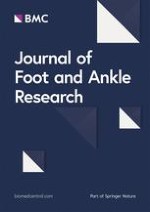Background
Methods
Results
Cluster | N° subjects ulcer/no ulcer | Push-off | Mid-stance | ||||
|---|---|---|---|---|---|---|---|
Peak PP | Mean PP | Von Mises | Peak PP | Mean PP | Von Mises | ||
1 | 0 / 3 | 0.423 | 0.108 | 0.000381 | 0.323 | 0.080 | 0.000251 |
0.052 | 0.023 | 0.000174 | 0.020 | 0.010 | 0.000044 | ||
2 | 1 / 4 | 0.371 | 0.097 | 0.000348 | 0.275 | 0.060 | 0.000245 |
0.041 | 0.019 | 0.000050 | 0.017 | 0.007 | 0.000024 | ||
3 | 5 / 3 | 0.390 | 0.104 | 0.000378 | 0.277 | 0.062 | 0.000228 |
0.035 | 0.007 | 0.000042 | 0.028 | 0.004 | 0.000021 | ||
